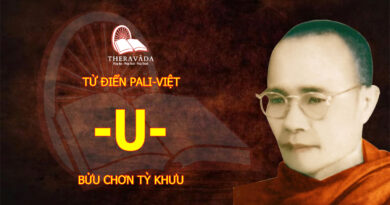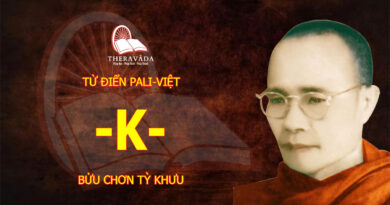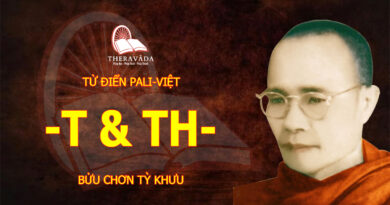Chapter 4: The Root Of The Problem – The Art Of Living
Chapter 4. THE ROOT OF THE PROBLEM
“The truth of suffering,” the Buddha said, “must be explored to its end.”1 On the night that he was to attain enlightenment, he sat down with the determination not to rise until he had understood how suffering originates and how it can be eradicated.
Suffering Defined
Clearly, he saw, suffering exists. This is an inescapable fact, no matter how unpalatable it may be. Suffering begins with the beginning of life. We have no conscious recollection of existence within the confines of the womb, but the common experience is that we emerge from it crying. Birth is a great trauma.
Having started life, we are all bound to encounter the sufferings of sickness and old age. Yet no matter how sick we may be, no matter how decayed and decrepit, none of us wants to die, because death is a great misery.
Every living creature must face all these sufferings. And as we pass through life, we are bound to encounter other sufferings, various types of physical or mental pain. We become involved with the unpleasant and separated from the pleasant. We fail to get what we want; instead we get what we do not want. All these situations are suffering.
These instances of suffering are readily apparent to anyone who thinks about it deeply. But the future Buddha was not to be satisfied with the limited explanations of the intellect. He continued probing within himself to experience the real nature of suffering, and he found that “attachment to the five aggregates is suffering.”2 At a very deep level, suffering is the inordinate attachment that each one of us has developed toward this body and toward this mind, with its cognitions, perceptions, sensations, and reactions. People cling strongly to their identity—their mental and physical being—when actually there are only evolving processes. This clinging to an unreal idea of oneself, to something that in fact is constantly changing, is suffering.
Attachment
There are several types of attachment. First there is the attachment to the habit of seeking sensual gratification. An addict takes a drug because he wishes to experience the pleasurable sensation that the drug produces in him, even though he knows that by taking the drug he reinforces his addiction. In the same way we are addicted to the condition of craving. As soon as one desire is satisfied, we generate another. The object is secondary; the fact is that we seek to maintain the state of craving continually, because this very craving produces in us a pleasurable sensation that we wish to prolong. Craving becomes a habit that we cannot break, an addiction. And just as an addict gradually develops tolerance towards his chosen drug and requires ever larger doses in order to achieve intoxication, our cravings steadily become stronger the more we seek to fulfill them. In this way we can never come to the end of craving. And so long as we crave, we can never be happy.
Another great attachment is to the “I,” the ego, the image we have of ourselves. For each of us, the “I” is the most important person in the world. We behave like a magnet surrounded by iron filings: it will automatically arrange the filings in a pattern centered on itself, and with just as little reflection we all instinctively try to arrange the world according to our liking, seeking to attract the pleasant and to repel the unpleasant. But none of us is alone in the world; one “I” is bound to come into conflict with another. The pattern each seeks to create is disturbed by the magnetic fields of others, and we ourselves become subject to attraction or repulsion. The result can only be unhappiness, suffering.
Nor do we limit attachment to the “I”: we extend it to “mine,” whatever belongs to us. We each develop great attachment to what we possess, because it is associated with us, it supports the image of “I.” This attachment would cause no problem if what one called “mine” were eternal, and the “I” remained to enjoy it eternally. But the fact is that sooner or later the “I” is separated from the “mine.” The parting time is bound to come. When it arrives, the greater the clinging to “mine,” the greater the suffering will be.
And attachment extends still further—to our views and our beliefs. No matter what their actual content may be, no matter whether they are right or wrong, if we are attached to them they will certainly make us unhappy. We are each convinced that our own views and traditions are the best and become very upset whenever we hear them criticized. If we try to explain our views and others do not accept them, again we become upset. We fail to recognize that each person has his or her own beliefs. It is futile to argue about which view is correct; more beneficial would be to set aside any preconceived notions and to try to see reality. But our attachment to views prevents us from doing so, keeping us unhappy.
Finally, there is attachment to religious forms and ceremonies. We tend to emphasize the external expressions of religion more than their underlying meaning and to feel that anyone who does not perform such ceremonies cannot be a truly religious person. We forget that without its essence, the formal aspect of religion is an empty shell. Piety in reciting prayers or performing ceremonies is valueless if the mind remains filled with anger, passion, and ill will. To be truly religious we must develop the religious attitude: purity of heart, love and compassion for all. But our attachment to the external forms of religion leads us to give more importance to the letter of it than the spirit. We miss the essence of religion and therefore remain miserable.
All our sufferings, whatever they may be, are connected to one or another of these attachments. Attachment and suffering are always found together.
Conditioned Arising: The Chain of Cause and Effect by Which Suffering Originates
What causes attachment? How does it arise? Analyzing his own nature, the future Buddha found that it develops because of the momentary mental reactions of liking and disliking. The brief, unconscious reactions of the mind are repeated and intensified moment after moment, growing into powerful attractions and repulsions, into all our attachments. Attachment is merely the developed form of the fleeting reaction. This is the immediate cause of suffering.
What causes reactions of liking and disliking? Looking deeper he saw that they occur because of sensation. We feel a pleasant sensation and start liking it; we feel an unpleasant sensation and start disliking it.
Now why these sensations? What causes them? Examining still further within himself he saw that they arise because of contact: contact of the eye with a vision, contact of the ear with a sound, contact of the nose with an odour, contact of the tongue with a taste, contact of the body with something tangible, contact of the mind with any thought, emotion, idea, imagination, or memory. Through the five physical senses and the mind we experience the world. Whenever an object or phenomenon contacts any of these six bases of experience, a sensation is produced, pleasant or unpleasant.
And why does contact occur in the first place? The future Buddha saw that because of the existence of the six sensory bases—the five physical senses and the mind—contact is bound to occur. The world is full of countless phenomena: sights, sounds, odours, flavours, textures, various thoughts and emotions. So long as our receivers are functioning, contact is inevitable.
Then why do the six sensory bases exist? Because they are essential aspects of the flow of mind and matter. And why this flow of mind and matter? What causes it to occur? The future Buddha understood that the process arises because of consciousness, the act of cognition which separates the world into the knower and the known, subject and object, “I” and “other.” From this separation results identity, “birth.” Every moment consciousness arises and assumes a specific mental and physical form. In the next moment, again, consciousness takes a slightly different form. Throughout one’s existence, consciousness flows and changes. At last comes death, but consciousness does not stop there: without any interval, in the next moment, it assumes a new form. From one existence to the next, life after life, the flow of consciousness continues.
Then what causes this flow of consciousness? He saw that it arises because of reaction. The mind is constantly reacting, and every reaction gives impetus to the flow of consciousness so that it continues to the next moment. The stronger a reaction, the greater the impetus that it gives. The slight reaction of one moment sustains the flow of consciousness only for a moment. But if that momentary reaction of liking and disliking intensifies into craving or aversion, it gains in strength and sustains the flow of consciousness for many moments, for minutes, for hours. And if the reaction of craving and aversion intensifies still further, it sustains the flow for days, for months, perhaps for years. And if throughout life one keeps repeating and intensifying certain reactions, they develop a strength sufficient to sustain the flow of consciousness not only from one moment to the next, from one day to the next, from one year to the next, but from one life to the next.
And what causes these reactions? Observing at the deepest level of reality, he understood that reaction occurs because of ignorance. We are unaware of the fact that we react, and unaware of the real nature of what we react to. We are ignorant of the impermanent, impersonal nature of our existence and ignorant that attachment to it brings nothing but suffering. Not knowing our real nature, we react blindly. Not even knowing that we have reacted, we persist in our blind reactions and allow them to intensify. Thus we become imprisoned in the habit of reacting, because of ignorance.
This is how the Wheel of Suffering starts turning:
If ignorance arises, reaction occurs;
if reaction arises, consciousness occurs;
if consciousness arises, mind-and-matter occur; if mind-and-matter arise, the six senses occur; if the six senses arise, contact occurs; if contact arises, sensation occurs;
if sensation arises, craving and aversion occur; if craving and aversion arise, attachment occurs;
if attachment arises, the process of becoming occurs; if the process of becoming arises, birth occurs;
if birth arises, decay and death occur, together with sorrow, lamentation, physical and mental suffering, and tribulations.
Thus arises this entire mass of suffering.3
By this chain of cause and effect—conditioned arising—we have been brought into our present state of existence and face a future of suffering.
At last the truth was clear to him: suffering begins with ignorance about the reality of our true nature, about the phenomenon labelled
“I”. And the next cause of suffering is saṅkhāra, the mental habit of reaction. Blinded by ignorance, we generate reactions of craving and aversion, which develop into attachment, leading to all types of unhappiness. The habit of reacting is the kamma, the shaper of our future. And the reaction arises only because of ignorance about our real nature. Ignorance, craving, and aversion are the three roots from which grow all our sufferings in life.
The Way out of Suffering
Having understood suffering and its origin, the future Buddha then faced the next question: how can suffering be brought to an end? By remembering the law of kamma, of cause and effect: “If this exists, that occurs; that arises from the arising of this. If this does not exist, that does not occur; that ceases from the ceasing of this.”4 Nothing happens without a cause. If the cause is eradicated, there will be no effect. In this way, the process of the arising of suffering can be reversed:
If ignorance is eradicated and completely ceases, reaction ceases; if reaction ceases, consciousness ceases;
if consciousness ceases, mind-and-matter cease; if mind-and-matter ceases, the six senses cease; if the six senses cease, contact ceases; if contact ceases, sensation ceases;
if sensation ceases, craving and aversion cease; if craving and aversion cease, attachment ceases;
if attachment ceases, the process of becoming ceases; if the process of becoming ceases, birth ceases;
if birth ceases, decay and death cease, together with sorrow, lamentation, physical and mental suffering and tribulations.
Thus this entire mass of suffering ceases.5
If we put an end to ignorance, then there will be no blind reactions that bring in their wake all manner of suffering. And if there is no more suffering, then we shall experience real peace, real happiness. The wheel of suffering can change into the wheel of liberation.
This is what Siddhattha Gotama did in order to achieve enlightenment. This is what he taught others to do. He said,
By yourself committing wrong
you defile yourself.
By yourself not doing wrong
We are each responsible for the reactions that cause our suffering. By accepting our responsibility we can learn how to eliminate suffering.
The Flow of Successive Existences
By the Wheel of Conditioned Arising the Buddha explained the process of rebirth or saṃsāra. In the India of his time, this concept was commonly accepted as fact. For many people today, it may seem to be an alien, perhaps untenable, doctrine. Before accepting or rejecting it, however, one should understand what it is and what it is not.
Saṃsāra is the cycle of repeated existences, the succession of past and future lives. Our deeds are the force that impels us into life after life. Each life, low or high, will be as our deeds were, base or noble. In this respect the concept is not essentially different from that of many religions that teach a future existence where we shall receive retribution or reward for our actions in this life. The Buddha realized, however, that in even the most exalted existence suffering can be found. Therefore we should strive not for a fortunate rebirth, since no rebirth is wholly fortunate. Our aim should rather be liberation from all suffering. When we free ourselves from the cycle of suffering, we experience an unalloyed happiness greater than any worldly pleasure. The Buddha taught a way to experience such happiness in this very life.
Saṃsāra is not the popular idea of the transmigration of a soul or self that maintains a fixed identity through repeated incarnations. This, the Buddha said, is precisely what does not happen. He insisted that there is no unchanging identity that passes from life to life: “It is just as from the cow comes milk; from milk, curds; from curds, butter; from fresh butter, clarified butter; from clarified butter, the creamy skimmings. When there is milk, it is not considered to be curds, or fresh butter, or clarified butter, or skimmings. Similarly at any time only the present state of existence is considered to be real, and not a past or future one.”7
The Buddha held neither that a fixed ego-principle is reincarnated in successive lives, nor that there is no past or future existence. Instead he realized and taught that only the process of becoming continues from one existence to another, so long as our actions give impetus to the process.
Even if one believes in no existence other than the present, still the Wheel of Conditioned Arising has relevance. Every moment that we are ignorant of our own blind reactions, we create suffering which we experience here and now. If we remove the ignorance and cease reacting blindly, we shall experience the resulting peace here and now. Heaven and hell exist here and now; they can be experienced within this life, within this body. The Buddha said, “Even if (one believes) there is no other world, no future reward for good actions or punishment for evil ones, still in this very life one can live happily, by keeping oneself free from hatred, ill will, and anxiety.”8
Regardless of belief or disbelief in past or future existences, we still face the problems of the present life, problems caused by our own blind reactions. Most important for us is to solve these problems now, to take steps toward ending our suffering by ending the habit of reaction, and to experience now the happiness of liberation.
Bài viết này được trích từ cuốn sách The Art Of Living – Thiền Sư S.N.Goenka và William Hart.




